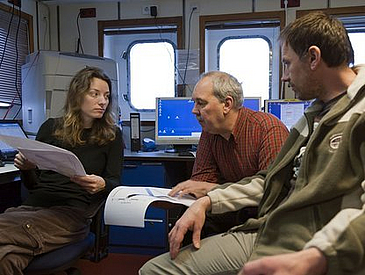An international group of researchers from the University of Bremen has discovered more than 130 active methane seeps on the ocean floor off the coast of the sub-Antarctic island of South Georgia. This is the first piece of evidence to confirm that methane, a greenhouse gas, is also escaping from the seabed in the Southern Ocean. The research team led by Gerhard Bohrmann, a professor at the University of Bremen’s MARUM Center for Marine Environmental Sciences, recently published their findings in the journal Earth and Planetary Science Letters.
According to the Intergovernmental Panel on Climate Change (IPCC), the greenhouse gas methane is 21 times more potent than carbon dioxide. It is therefore hardly surprising that methane emissions are in the focus of research scientists worldwide. However, it still not known just how much methane is actually released into the atmosphere. To find out, in early 2013 a team of German, British and American scientists joined an expedition on the Polarstern research vessel in an attempt to piece together the Antarctic part of the global methane puzzle.
“Using the depth-sounding equipment on board the vessel, we investigated two bays on the North coast of South Georgia Island…”, says Gerhard Bohrmann, leader of the expedition. “…and we carried out an especially thorough search in Cumberland Bay.”
“The methane escapes in bubbles which appear as small flags on the echogram screens. After rising to a depth of about 25 meters under the surface, these bubbles disperse”, says MARUM scientist Dr. Miriam Römer, lead author of the recently published article. She goes on to explain: “In all, we were able to identify a total of 133 methane flags in depths between 130 and 390 meters, more than half of them in Cumberland Bay.” On average, the flags reached a height of some 70 meters. The highest one, though, measured a staggering 220 meters. Notwithstanding, only small amounts of methane manage to rise to the water layers near the surface. The investigations show that so far the gas emissions off the coast of South Georgia are unlikely to have escaped into the atmosphere and contributed to the greenhouse effect.
With its deep fjords and bays, the rugged north coast of South Georgia Island lends itself to the formation of methane flags. The almost 3,000-meter high mountains on the 100-mile-long island are covered by huge glaciers. The ice-flows that once stretched far out into the Southern Ocean gouged deep troughs in the sea bed, which over the path of time filled with sediments eroded from the land. In a parallel development, the Antarctic Circumpolar Current lifted nutriments from the ocean depths to the upper level of the sea filled with light. Dr. Sabine Kasten, member of the expedition team and leader of the Marine Geochemistry Section of the Alfred Wegener Institute in Bremerhaven, explains what happens then: “High levels of sedimentation with large amounts of organic material lead to the microbial activity that creates the right conditions for the formation of methane”.
The recently published discovery augments the long and fast-growing list of methane seeps in the world’s oceans, a subject of research at MARUM for a long time now. Another expedition to South Georgia Island is in planning. There are still a lot of unanswered questions: “The methane emissions are irregular; it could be that the rhythm is determined by the tide, storms, earthquakes and various other factors”, says MARUM’s Miriam Römer. “There is still a lot of research to be done before we can compile any accurate data and quantify the level of methane seeps in the region.”
Article: M. Römer et al.: First evidence of widespread active methane seepage in the Southern Ocean, off the sub-Antarctic island of South Georgia; in Earth and Planetary Science Letters403 (2014), S. 166 – 177.
http://www.sciencedirect.com/science/article/pii/S0012821X1400421X
For more information / interview requests / images, please contact:
Albert Gerdes
MARUM Communication Office
Phone: +49 421 218-65540
email: agerdesprotect me ?!marumprotect me ?!.de

